16、网络编程
大约 4 分钟
网络编程
网络编程中的两个要素:
- IP和端口号
- 网络通信协议:TCP/IP
InetAdress类:
- java使用InetAddress类代表IP
- 获取InetAddress实例:
getLocalHost(),getByName() - 获取IP:
getHostAddress - 获取IP地址的主机名:
geHostName() - 端口号与IP地址的组合得出一个网络套接字:
socket
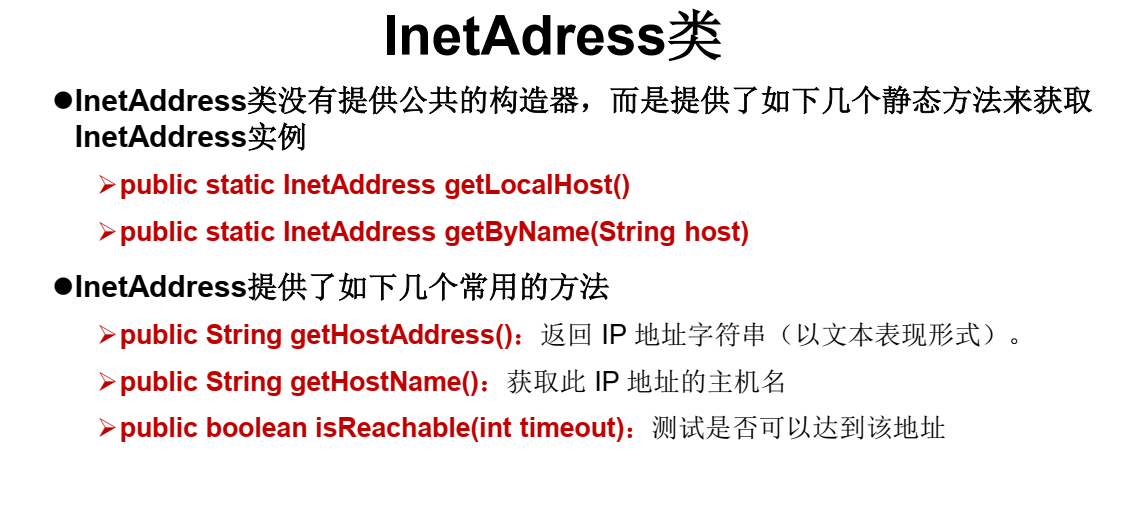
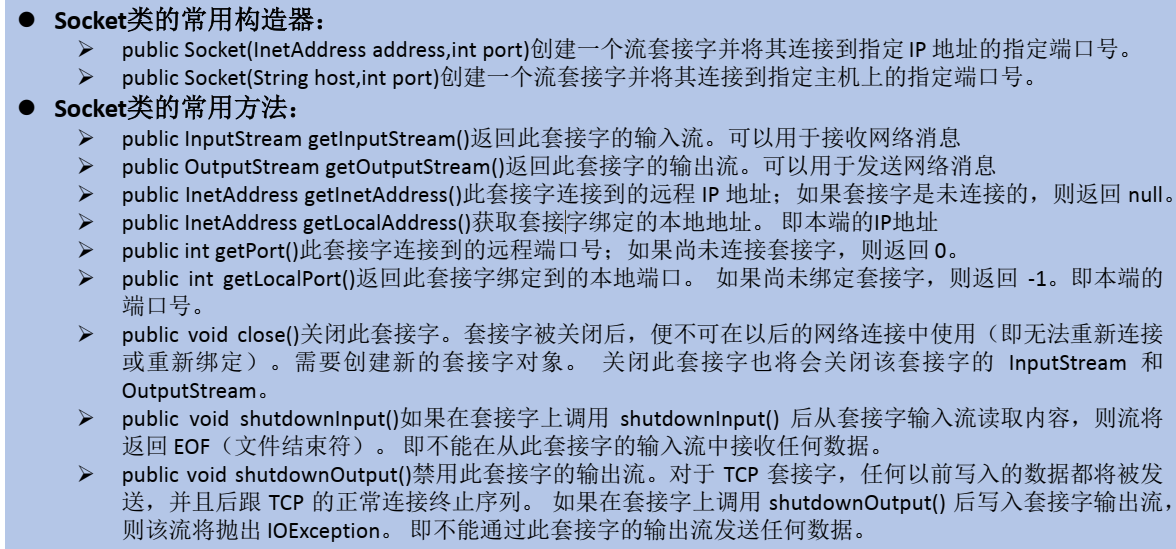
1、实现TCP网络编程
客户端Socket:
- 创建 Socket:
根据指定服务端的 IP 地址或端口号构造 Socket 类对象。
若服务器端响应,则建立客户端到服务器的通信线路。
若连接失败,会出现异常。 - 打开连接到 Socket 的输入/出流:
使用getInputStream()方法获得输入流
使用getOutputStream()方法获得输出流,进行数据传输 - 对 Socket 进行读/写操作:
通过输入流读取服务器放入线路的信息(但不能读取自己放入线路的信息),通过输出流将信息写入线程。
4、关闭 Socket: 断开连接,释放线路
服务端:
- 调用
ServerSocket(int port): 创建一个服务器端套接字,并绑定到指定端口上。监听客户端的请求。 - 调用
accept(): 接受连接,返回通信套接字对象。 - 调用该Socket类对象的
getOutputStream()和getInputStream (): 获取输出流和输入流,开始网络数据的发送和接收。 - 关闭ServerSocket和Socket对象: 客户端访问结束,关闭通信套接字。
/* 实现TCP网络编程
* 例一:客户端发送信息给服务端,服务端将数据显示在控制台
*/
public class TCPTest1 {
//客户端
@Test
public void client(){
Socket socket = null;
OutputStream os = null;
try {
//1、创建socket对象,指明服务器的ip和端口号
InetAddress inet = InetAddress.getByName("192.168.80.1");
socket = new Socket(inet,8899);
//2、获取一个输出流、用于输出数据
os = socket.getOutputStream();
//3、写出数据造作
os.write("hi,i am client".getBytes());
} catch (IOException e) {
//4、资源关闭
e.printStackTrace();
} finally {
if(os != null){
try {
os.close();
} catch (IOException e) {
e.printStackTrace();
}
}
if(socket != null){
try {
socket.close();
} catch (IOException e) {
e.printStackTrace();
}
}
}
}
@Test
public void server(){
ServerSocket ss = null;
Socket socket = null;
InputStream is = null;
ByteArrayOutputStream baos = null;
try {
//1、创建服务器端的socket,指明自己的端口号
ss = new ServerSocket(8899);
//2、调用accept方法,表示接受来自客户端的socket
socket = ss.accept();
//3、获取输入流
is = socket.getInputStream();
//不介意这样写,可能会乱码
// byte[] buffer = new byte[20];
// int len;
// while((len = is.read(buffer) != -1){
// String str = new String(buffer,0,len);
// System.out.print(str);
//4、读取输入流的数据
baos = new ByteArrayOutputStream();
byte[] buffer = new byte[5];
int len;
while ((len = is.read(buffer)) != -1){
baos.write(buffer,0,len);
}
System.out.println(baos.toString());
System.out.println("收到了来自于:"+socket.getInetAddress().getHostAddress()+"的数据");
} catch (IOException e) {
e.printStackTrace();
} finally {
//5、关闭资源
if(baos != null){
try {
baos.close();
} catch (IOException e) {
e.printStackTrace();
}
}
if(is != null){
try {
is.close();
} catch (IOException e) {
e.printStackTrace();
}
}
if(socket != null){
try {
socket.close();
} catch (IOException e) {
e.printStackTrace();
}
}
if(ss != null){
try {
ss.close();
} catch (IOException e) {
e.printStackTrace();
}
}
}
}
}
/* 实现TCP网络编程
* 例题2:客户端发送文件给服务端,服务端将文件保存在本地
*/
public class TCPTest2 {
//注:异常处理任应使用try-catch-finally
@Test
public void client() throws IOException {
//
Socket socket = new Socket(InetAddress.getByName("127.0.0.1"),9090);
OutputStream os = socket.getOutputStream();
FileInputStream fis = new FileInputStream(new File("tamakoTest1.jpg"));
//
byte[] buffer = new byte[1024];
int len;
while((len = fis.read(buffer)) != -1){
os.write(buffer,0,len);
}
//
fis.close();
os.close();
socket.close();
}
@Test
public void server() throws IOException {
ServerSocket ss = new ServerSocket(9090);
Socket socket = ss.accept();
InputStream is = socket.getInputStream();
FileOutputStream fos = new FileOutputStream(new File("tamakoTest2.jpg"));
byte[] buffer = new byte[1024];
int len;
while ((len = is.read(buffer)) != -1){
fos.write(buffer,0,len);
}
fos.close();
is.close();
socket.close();
ss.close();
}
}
/* 例题三:客户端发送文件给服务端,服务端保存至本地,返回“发送成功”给客户端,并关闭相应连接
*/
public class TCPTest3 {
@Test
public void client() throws IOException {
//
Socket socket = new Socket(InetAddress.getByName("127.0.0.1"),9900);
OutputStream os = socket.getOutputStream();
FileInputStream fis = new FileInputStream("tamakoTest.jpg");
byte[] buffer = new byte[1024];
int len;
while ((len = fis.read(buffer)) != -1){
os.write(buffer,0,len);
}
//关闭数据输出
socket.shutdownOutput();
//5、接受来自于服务器端的,并显示到控制台上
InputStream is = socket.getInputStream();
ByteArrayOutputStream baos = new ByteArrayOutputStream();
byte[] buffer2 = new byte[20];
int len1;
while ((len1 = is.read(buffer2)) != -1){
baos.write(buffer,0,len1);
}
System.out.println(baos.toString());
//
fis.close();
os.close();
socket.close();
is.close();
baos.close();
}
@Test
public void server() throws IOException {
ServerSocket ss = new ServerSocket(9900);
Socket socket = ss.accept();
System.out.println("conncetion!");
InputStream is = socket.getInputStream();
FileOutputStream fos = new FileOutputStream(new File("tamakoTest3.jpg"));
byte[] buffer = new byte[1024];
int len;
while((len = is.read(buffer)) != -1){
fos.write(buffer,0,len);
}
System.out.println("complete");
//服务器端给与客户端反馈
OutputStream os = socket.getOutputStream();
os.write("hello".getBytes());
os.flush();
//
os.close();
fos.close();
is.close();
socket.close();
ss.close();
}
}
2、实现UDP网络编程
public class UDPTest {
//发送端
@Test
public void sender() throws IOException {
DatagramSocket socket = new DatagramSocket();
String str = "UDP function";
byte[] data = str.getBytes();
InetAddress inet = InetAddress.getLocalHost();
DatagramPacket packet = new DatagramPacket(data,0,data.length,inet,9090);
socket.send(packet);
socket.close();
}
//接收端
@Test
public void receiver() throws IOException {
DatagramSocket socket = new DatagramSocket(9090);
byte[] buffer = new byte[100];
DatagramPacket packet = new DatagramPacket(buffer,0,buffer.length);
socket.receive(packet);
System.out.println(new String(packet.getData(),0,packet.getLength()));
socket.close();
}
}
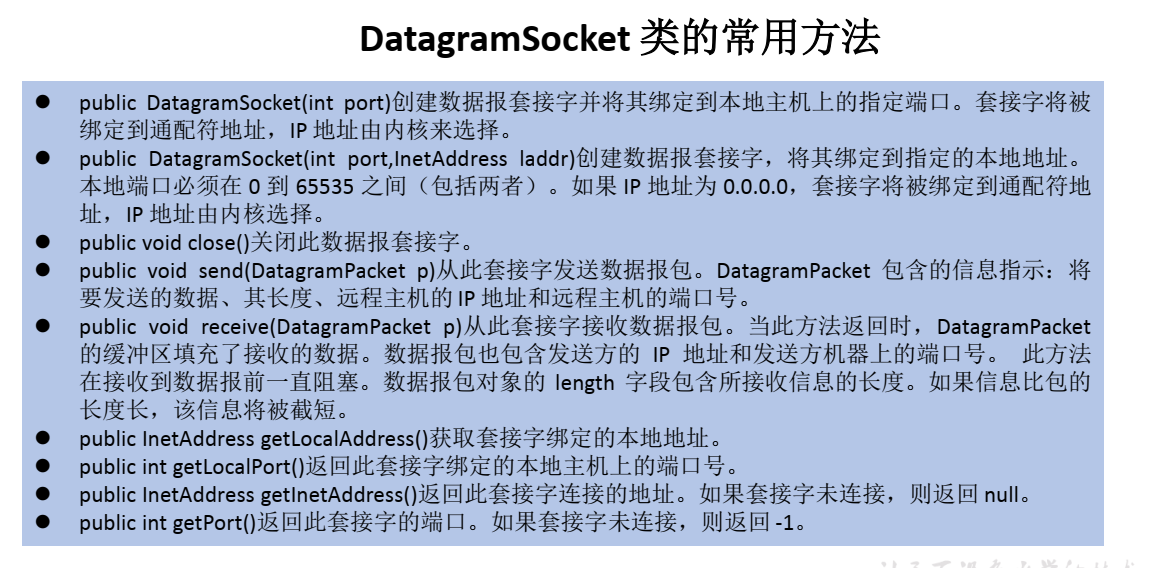
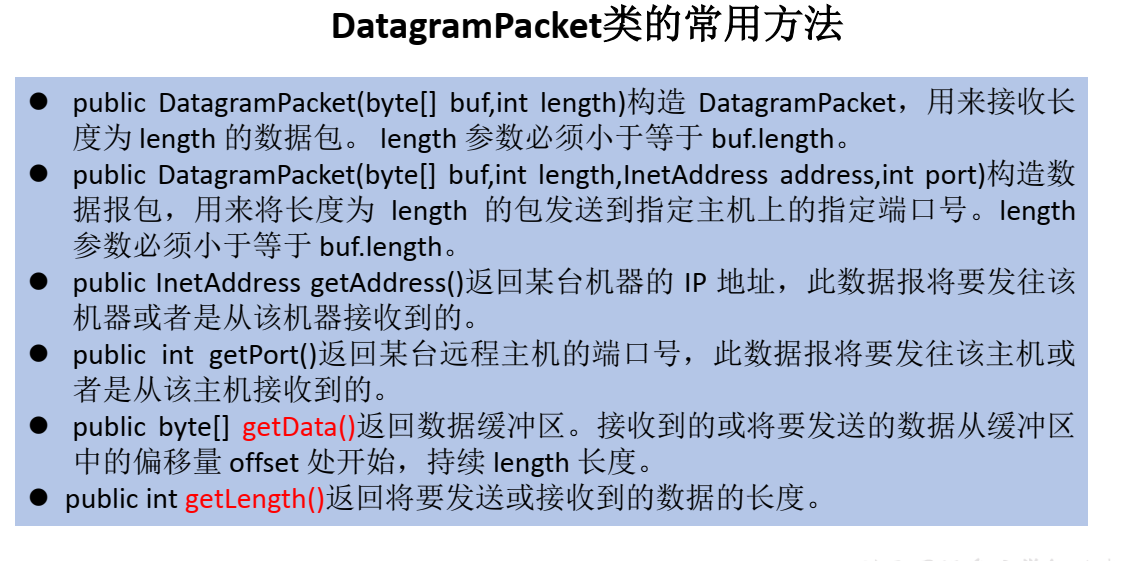
3、URL网络编程
URL:统一资源定位符
包括:协议 主机名 端口号 资源地址 参数列表
public class URLTest {
public static void main(String[] args) {
try {
URL url = new URL("http://localhost:8080/examples/beauty.jpg?username=Tom");
System.out.println(url.getProtocol());
System.out.println(url.getHost());
System.out.println(url.getPath());
System.out.println(url.getFile());
System.out.println(url.getQuery());
} catch (MalformedURLException e) {
e.printStackTrace();
}
}
}
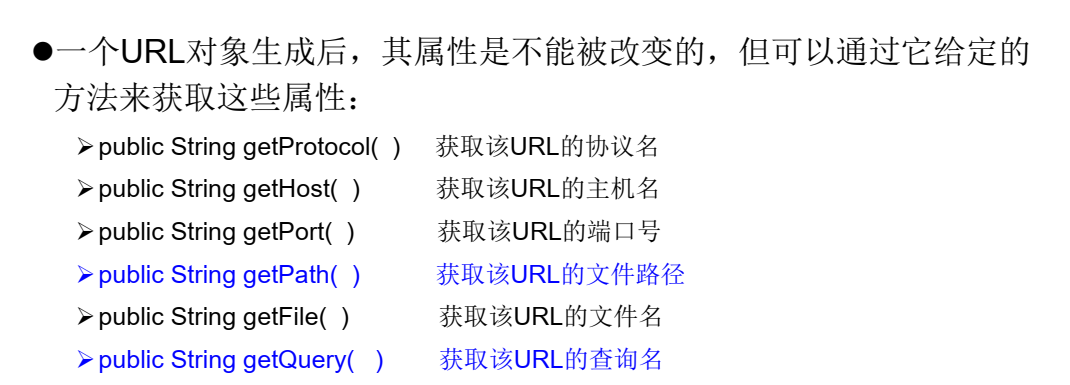
public class URLTest1 {
public static void main(String[] args) {
HttpURLConnection urlConnection = null;
InputStream is = null;
FileOutputStream fos = null;
try {
URL url = new URL("http://localhost:8080/examples/beauty.jpg?username=Tom");
urlConnection = (HttpURLConnection) url.openConnection();
urlConnection.connect();
is = urlConnection.getInputStream();
fos = new FileOutputStream("day10\\tamakoTest4.txt");
byte[] buffer = new byte[1024];
int len;
while((len = is.read(buffer)) != -1){
fos.write(buffer,0,len);
}
} catch (IOException e) {
e.printStackTrace();
} finally {
//关闭资源
if(is != null){
try {
is.close();
} catch (IOException e) {
e.printStackTrace();
}
}
if(fos != null){
try {
fos.close();
} catch (IOException e) {
e.printStackTrace();
}
}
if(urlConnection != null)
urlConnection.disconnect();
}
}
}
Powered by Waline v2.15.5